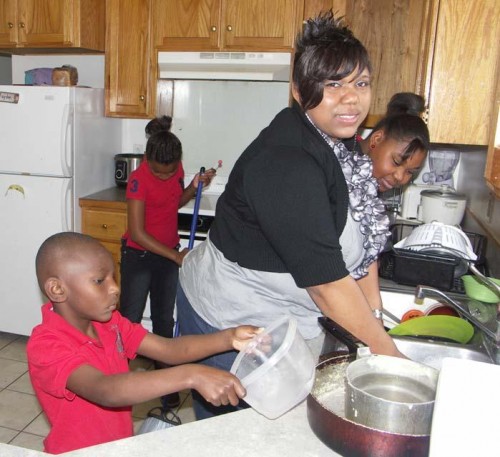Tuesday, Dec. 13
December 13, 2011
Hubert P. Rivere
December 15, 2011At 6 a.m., Roxanne Diggs and her three children, ages 5, 9 and 12, are up and getting their day started. By 7 a.m. everyone is out the door and once her kids are on the school bus this 32-year-old parent commutes from Thibodaux to Houma where she labors in a billing center between eight and nine hours a day Monday through Friday.
After school, the children are met at the bus stop by their aunt and escorted to the duplex where they live. The next agenda item is to receive a scheduled call on the telephone from Mom, during which each child lets her know they are home safe.
With specific instructions, the children do their homework then perform chores before Diggs gets home, sometimes as late at 7 p.m.
“When I get home, I go over their homework and we prepare a meal,” Diggs said. Sharing dinner is followed by each family member taking part in the cleanup. Then it is time to get ready for the next day.
“Everyone is in bed and lights out at 9 p.m.,” Diggs said. “Tomorrow we will do it again.”
Diggs is representative of 9.3 percent of Louisiana’s population. She is a single female head of household with children under 18 years of age.
This working mom has something else in common with most members of her demographic. They are women holding down fulltime jobs, raising a family and barely able to make ends meet. The category is commonly referred to as the working poor, but federal government programs do not consider them as living in poverty.
In Diggs’ case, she earns $50 too much a year to receive government assistance for the care, clothing, feeding and shelter of her son and two daughters.
“Living from check to check is very difficult,” Diggs said. “When I’m finished with the bills, sometimes we don’t have much to buy food.”
The most recent estimates released by the U.S. Census Bureau state that between 2007 and 2010, the poverty rate for U.S. children increased in one-third of all counties across the nation.
Among states, Mississippi has the highest overall poverty level at 22.4 percent and New Hampshire has the lowest at 8.6 percent.
In Louisiana, the 2010 Census revealed the state has a poverty level of 18.9 percent with the poorest area being East Carroll Parish with a current poverty rate at 40.3 percent. St. Tammany Parish has the lowest poverty rate at 9.2 percent.
In Lafourche Parish, single women with children under 18 living under the official poverty level account for 26.4 percent of the total population. In St. Mary Parish that segment of the population is counted as 40.3 percent, and in Terrebonne Parish the figure is listed at 47.7 percent.
Between Census Bureau counts during 2000 and 2010, the Tri-parish region registered an overall decline in poverty levels. Lafourche Parish went from 16.5 percent to a current level of 13.3 percent. St. Mary Parish went from 23.6 percent to 20.6 percent. Terrebonne Parish numbers decreased from 19.6 percent to 18.3 percent.
Those declining numbers mean little to Diggs and others who might not personally consider themselves impoverished, but know they certainly are close to it.
Kids Count Coordinator Teresa Falgoust, with the Agenda for Children of Louisiana, said federal government formulas for measuring poverty are outdated, and need to become realistic regarding who is living in need. This family advocate said that one could almost double the numbers listed to secure a genuine picture of poverty in America.
“One thing that a lot of researchers have been paying attention to and trying to solve is how to accurately measure poverty,” Falgoust said. “The current poverty measure used by the Census Bureau is inadequate for measuring how much families really need to make ends meet.”
Falgoust explained that the federal government measurement of poverty is based on a formula adopted in the early 1960s. “At the time an average family spent a third of its income on food,” she said. “So what they did was multiply the cost of what was called a Thrifty Food Plan by three. Of course in the meantime a lot has changed and families have more costs [such as child care and other expenses uncommon half a century ago]. The cost of food has actually gone down in proportion to its budget. So, today the average family spends about a seventh of its income on food, but we are still multiplying the cost of food by three to determine our poverty measure. If we developed a measure today it would be at a higher threshold.”
The Kids Count coordinator pointed to a study by the National Center for Children in Poverty. In that report, researchers determined that the federal poverty guideline is at about one-fourth the level it should be in the present economy.
The 2010 Department of Health and Human Services poverty measurement for the 48 continental states, lists the annual income constituting poverty for a family of four as being at $22,350. The NCCP study, which was constructed in 2008, said that income level more realistically should be $42,400 for the same family of four to meet its basic needs.
“Right now, we are real busy,” Diocese of Houma-Terrebonne Good Samaritan Food Bank Manager Reynold Pitre said of his store in Houma. “I don’t know what happened to the economy, but last month we had 254 families that we helped. People are losing jobs around Houma, and the ones not losing jobs are getting their hours cut.”
Pitre, like Falgoust, said there are probably more families that need help than qualify for assistance not only from federal and state agencies but charitable organizations as well.
“If people are getting food stamps I need to know how much,” Pitre said to explain his organization’s requirements for assistance. “They need to have a proof of income if they have any, their bills and their Social Security number. I have an income guideline we go by. It is the same one that the food stamp office and Second Harvest use.”
Pitre said that recipients of goods from the food bank also are required to first undergo a screening process.
“We are going through a lot of food,” Pitre said. “Thank God for the holidays because people are generous during the holidays.”
Falgoust agreed with Pitre that some times of the year are more difficult for the working poor and those living in severe poverty. She added that on the other side of the income equation, the poverty calculator misses elements that could be considered income.
“The poverty measure doesn’t take into consideration the impact of most anti-poverty programs,” Falgoust said. “For example, it doesn’t count your earned income tax credit as income. This is one of the biggest anti-poverty programs we have in the country. It also does not include the value of things like food stamps or health care [benefits]. We are not really measuring what we are doing to help people and we are not developing an adequate measure of what families need to make ends meet without any of those.”
Diggs said she stresses the importance of education and faith to her children with the hope that they will not have to struggle as she does.
“God is my provider,” she said. “I have a good support system and that is important. It doesn’t have to be financial. Just a word of encouragement helps. I count my blessings every day. That makes me feel better.
“When I was growing up I thought poverty meant being homeless. Now I realize that poverty is one paycheck away from being homeless. That means living from check to check you’re in poverty. You never know until you are going through it. Just count your blessings.”
Regardless of what the government, researchers or even charitable organizations have said, for Diggs and working families like hers the reality remains that basic living is not easy and there are more people just getting by than might be admitted.
Then, tomorrow is another day.
Working together, Roxanne Diggs has her children Jayden, 5, and Kerriana, 12, help with dinner dishes while 9-year-old Ashanti sweeps the kitchen floor. MIKE NIXON










